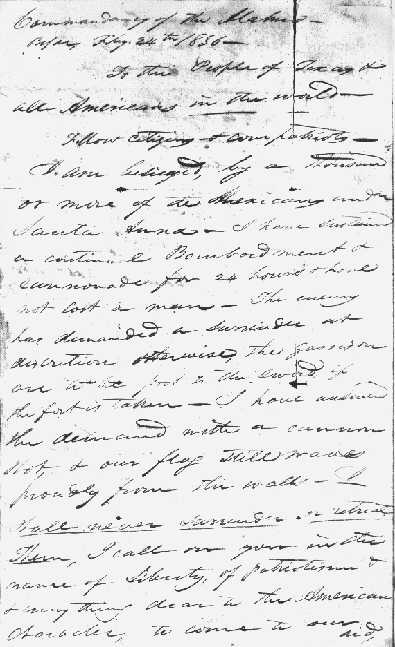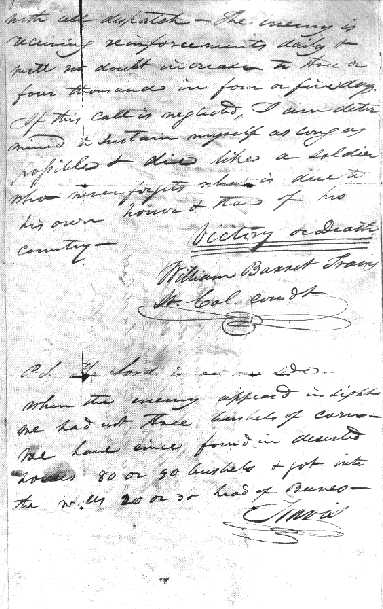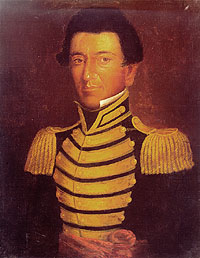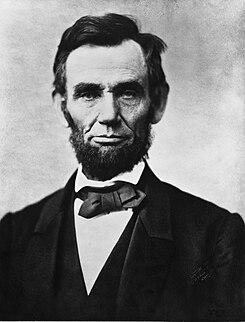 |
| D.P. Cummings |
I have become enthralled by the letters from eyewitnesses to the events of the Texas Revolution. Their historical significance can not be underestimated. The letter you are about to read comes to us from the General Land Office of all places. The contnent of the letter is absolutely incredible. see for yourself.
The letter comes from David P.Cummings and is dated February 14, 1838.
San Antonio de Bexar
February 14th 1835 (1835 is a transcription error)
Dear Father,
I wrote you from Gonzales and soon after
left there for this place yet under different views from
what I stated in as a sudden attack was expected on
our Garrison here and we were called on for assistance
It is however fully ascertained that we have nothing
of the kind to apprehend before a month or six weeks as
the Enemy have not yet crossed the Rio Grande 180 mi
distant from this place nor are they expected to make
any movement this way until the weather becomes warm
or until the grass is sufficiently up to support their horses
we concive it however, important to be prepared as a
heavy attack is expected from Sant Anna himself
in the Spring as no doubt the despot will use every possible
means and strain every nerve to conquer and exterminate
us from the land – in this we have no fear and are confident
that Texas cannot only sustain what she now holds
but take Mexico itself did she think on conquest.
The northern Indians have joined to our assistance and
the volunteers from the United States are every day flocking
to our ranks which from the liberal promises of the Government
and desireable resources of the Country seem determined
to sustain themselves or sink in the attempt. Many it is true
have left the Country and returned home to their friends
and pleasures but of such Texas has no use for and
her agents in the U States should be careful whom they
send us for assistance we want men of determined
spirits , that can undergo hardships and deprivation
otherwise they are only a pest and expense to their
fellow soldiers – to the first class (tho I would be the
last to advise in any case) I say come on, there is
a fine field open to you all no matter how you are situated
or what may be your circumstances, at least come and
see the Country, as a farmer, mechanic or a soldier
you will do well – I believe no Country offers such
strong inducements to Emmigration, affording all the
convieniences of life that man can desire – what I write
is from my own observation and from what I hear
from those who have resided for years in the Country
I am to leave this to return to the Cibilo Creek in company
with 10 others to take up our lands we get as citizens which is more than 1100 acres for single men, man of
family 4428 acres our volunteer pay is 20$ per month
& 640 acres at close of the war.
Any communication to San Felipe de Austin
you may make with postage paid to the Boundary line I will
get or send to Stiles Duncan Natchitoches, he could
mail it to San Felipe as I would be very glad to hear from you all
It might be that I might be of some benefit
to you here provided any of you could have a mind to come
out and indeed to speak sincearly this would be the
Country for us all, nothing could induce me from
my determination of settling here, tho my disposition may
not be like most others. I should like you could once
see it – a visit by Jonathon would improve his health
I have been very healthy since I have been here and am
improving
Yours affectionately
D P Cummings
PS
There is one thing might be proper for me to add
Members have been elected to a Convention of all Texas
st
It meet on 1 March, which will make an immediate
declaration of independence – upon the faith of this
event great speculation is going on in lands, tho the office
for disposal of the public lands is not yet opened but
is expectid will be in a short time. The price of land
has risen greatly since the commencement of the war and
a declaration of Independence will bring them to vie with
those of the U States tho they can be purchased from 50 cts
to 5$ per acre by the League depending on their improvements
or convinience to settlements – No country is now settling faster
- as I will most probably be engaged in Surveying of public
lands I might be of Service to some of our friends in
procuring desireable or choice locations.
D P Cummings
Two passages of this letter stood out to me. The first, "in this we have no fear and are confident that Texas cannot only sustain what she now holds but take Mexico itself did she think on conquest." Mr. Cummings and his fellow Freedom Fighters were willing to die for the libertion of Texas from that despot, Santa Anna, knowing that their fellow Texans were equally ready to sacrifice everything they owned in order to live life as a free people.
The second part of the letter that caught my eye was this one: "the volunteers from the United States are every day flocking to our ranks which from the liberal promises of the Government and desireable resources of the Country seem determined to sustain themselves or sink in the attempt." Many people in the United States, themselves not far removed from their own War for Independence, were willing to pack up and head to Texas, a foreign country at that time, to make for themselves a life that would be one of prosperity and promise in the Country of Texas.
Both of these excerpts from Mr. Cummings' letter show that men yearn for freedom and liberty as much as they crave food and water. This is an instinct that is instilled in the soul of every human being by the Merciful Almighty God Himself. With unbreakable resolve and a Spirit in need of Freedom in each man that fought for Texas Independence, Santa Anna was doomed from the beginning of his military campaign. His fatal mistake was that he overlloked the fact that Texans are men and women are a people
forged of a hotter fire.. God bless these men and women. And may God continue to bless Texas.

















